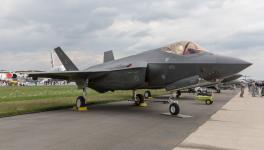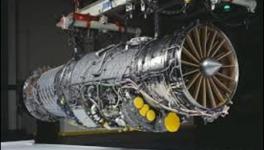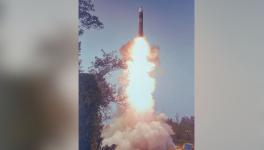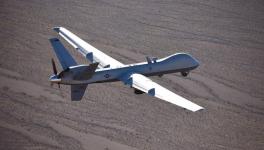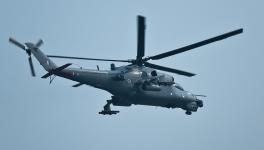US-India Drone, jet Engine Deals to Impact Indigenous Development
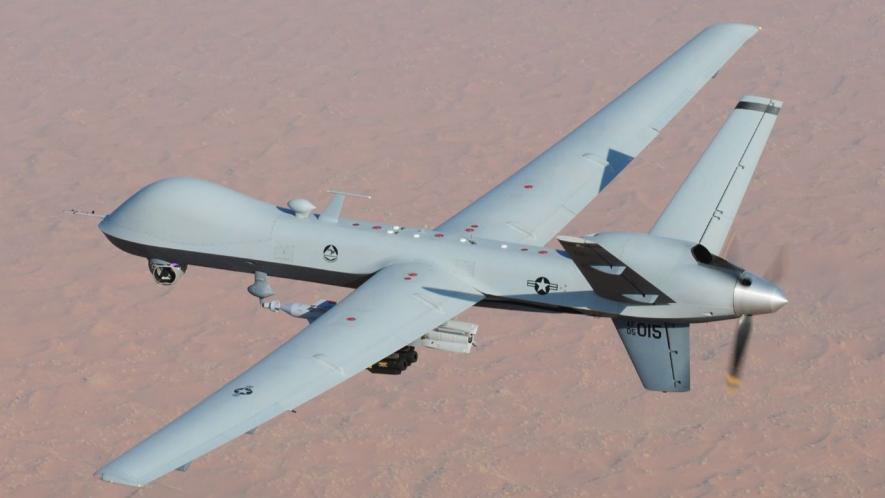
The Reapers make India even more interlinked with, and dependent on, US military systems. | (Image: Reaper MQ-9B; courtesy: Wikimedia Commons)
Two major headline-grabbing defence equipment deals, the focus of this article, were signed during the Prime Minister’s recent State visit to the US.
The US is to sell 31 unmanned armed Reaper MQ-9B drones to India, 15 for the Navy and eight each for the Army and Air Force. The drones, long sought by India, would provide a new and substantial intelligence-gathering, surveillance and reconnaissance (ISR) capability and, when necessary, the ability to strike at targets on land and on or under the sea-surface.
The deal includes assembly in India and setting up of a global MRO (maintenance, repair and overhaul) facility to cater to other Reaper users. The deal also envisages procuring 8-10% of components from within India, with negotiations on to try and increase this to 15-20%.
The US has also consented to a far-reaching agreement between General Electric (GE) Aerospace and Hindustan Aeronautics Ltd (HAL) for licensed production in India of the proven, high-performance F-414 jet engine to power the upcoming indigenous Light Combat Aircraft (LCA) Tejas Mk2, while its predecessor F-404 engines are already being used in the earlier LCA Tejas Mk1 and Mk1A versions.
This is indeed a rare arrangement by the US with a country which is not a formal US military ally and would be the first time a major US-origin military platform is manufactured in India.
Jet engines are the most complex and advanced element of jet aircraft (whether civilian or military) technology, developed and used by only a handful of countries, namely the US, the UK, France and Russia, with Germany and South Korea having capabilities in some niche areas and China arduously pursuing this goal and being reportedly close to but yet to achieve self-reliant design-development capability.
The GE F-414 deal has been tom-tommed in the Indian media as a major “transfer of technology” (ToT) agreement, implying it would help India break into this exclusive club. However, it remains to be seen if this is just licensed production, and how much design, data and proprietary knowledge are actually shared with HAL.
The Drone Deal
The US has agreed to a roughly $3 billion government-to-government sale to India under the Foreign Military Sales Act (FMS) of 31 best-in-class armed Reaper Remotely Piloted Vehicles (RPV) or drones made by General Atomics.
The Reaper (also called Guardian) is a High-Altitude Long-Endurance (HALE) drone or unmanned aerial vehicle (UAV, with a ceiling of over 50,000 feet, range of around 1,800 km, ability to fly for over 40 hours with external fuel tanks and munitions or about 27 hours fully loaded, and can also loiter over potential targets for almost 24 hours.
These capabilities provide the Indian Army and Air Force the ability to gather real-time information over several hundred kilometers away across LOC (Line of Control), LAC (Line of Actual Control) or international land borders while staying inside Indian air space, as well as carry out extensive surveillance over the seas around India, without putting too much load on India’s US-supplied Boeing P8i maritime surveillance aircraft.
The armed versions can carry a variety of weapons and a wide range of sensors, radar, sensor suites with daylight TV systems, infra-red imaging etc. The Sea Guardians or maritime version of the Reaper can also be equipped with sonobuoy management and control systems (SMCS) and sonobuoy ((i.e. buoys or floating devices with sonar) dispenser systems (SDS) with precision-guided munitions and small attack drones.
The actual weapons systems India wants, have not been spelt out yet. It is also not known if the Indian Reapers will come with protective pods with defences against electronic warfare and anti-aircraft systems. The Reapers can also be disassembled and easily transported in India’s large transport aircraft say, to the Andamans, further extending their operational coverage.
India has long been interested in unmanned aerial vehicles (UAVs) of different capabilities but, as so often happens in India, has been caught between conflicting demands for urgent induction and deployment, and a desire for indigenous development which, even if less expensive, may take longer.
The indigenous UAVs under development, such as the Rustom and the Tapas BH-201 (Tactical Advanced Platform for Aerial Surveillance Beyond Horizon) are mostly medium-altitude long endurance (MALE) drones with a ceiling of around 35,000 feet, and are still under development. A couple of HALE UAVs, one with a jet-engine, are some distance away. Meanwhile, India has acquired Israeli kamikaze drones and MALE Heron UAVs, but has faced limitations in satellite communications and problems in settling a deal to weaponise the Heron Mk2 in India.
Prolonged negotiations with the US, especially for armed drones, became mired in US domestic regulations and political hesitation, but some clarity emerged during the previous decade, with a shift in US strategic vision which envisaged a major role for India even without a formal alliance.
The Donald Trump Administration made a surprise offer of unarmed Sea Guardian (Reaper) drones to India in 2017, the first such offer to a non-ally country, The Indian Navy has been operating two Reapers over the past two years under lease and is reportedly happy with the over 10,000 hours of surveillance clocked.
With India signing up in 2020 to the fourth (Basic Exchange and Cooperation Agreement for Geospatial Intelligence or BECA) and last of the so-called foundational agreements which are required by the US to supply sensitive military equipment even to allies, the door was finally open for the US to consider supplying armed drones to India.
Some commentators in India have praised the US for its persistence in partnering with India despite not having landed big-ticket contracts such as for nuclear power stations or mega fighter-jet deals. At the same time, $20 billion worth of military equipment sales to India, covering a wide range of large transporters, helicopters and maritime reconnaissance aircraft, is good business!
There are two major down-sides to the deal. First, India having spent $3 billion on buying armed HALE Reapers, the indigenous development of UAVs is very likely to suffer setbacks. DRDO (Defence Research & Development Organisation) would do well to push for a clear strategic vision in this regard from both the government and the armed forces. DRDO may also think seriously about re-prioritising drone development toward lower-cost MALE and kamikaze drones.
Second, the Reapers make India even more interlinked with, and dependent on, US military systems especially its encrypted satellite communication systems essential for beyond-visual-range guidance of the drones. Some commentators have noted that the Reapers would be able to seamlessly integrate with other US-supplied airborne assets such as the Apache attack helicopters, P8i reconnaissance aircraft and so on, further underlining the interlinking and inter-operability with US military systems. India’s strategic autonomy will inevitably come under greater pressure.
GE Engines
Another long-awaited deal was for the acquisition and domestic manufacture of GE F-414 aero-engines for the forthcoming indigenous Tejas Mk2 fighter, which is expected to enter into service at the end of the decade, with roll-out and flight testing scheduled for 2024 and 2027, respectively.
The GE F-414 is a contemporary engine but not new by any means. It is built on the platform of its predecessor, the F-404, but is a significant advance over it in terms of design, materials and manufacturing technologies. The F-404 engine with 84 kN (kilo Newtons) of thrust powers the indigenous LCA Tejas Mk1, 40 of which are already in service, and 83 Mk1A fighters which are due to be delivered by HAL from 2024-2029 at the rate of around 16 per year. Together, these involve 75 and 99 F-404 engines, respectively.
Ironically, the F-404 engine is also powered by the Swedish Saab Viggen which India wanted to buy in the 1970s, but the US banned the supply of American engines! Between the F-404 and F-414, 5,600 engines of this family of engines, including 1,600 F-414s, have been supplied by GE and are currently operational. The F-414 also powers the US frontline Boeing F/A-18 fighters.
The F-414 engine was selected for use in the LCA Mk2 aircraft which is larger and heavier than the LCA Mk1 or Mk1A, and, therefore, required a more powerful engine. Being part of the same family of engines and having similar external dimensions, the F-414 with 98kN thrust was the natural successor to the F-404 for use in the LCA Mk2. GE has already supplied 8 F-414 engines to DRDO/HAL for prototype development of the LCA Mk2. While exact numbers have not been finalised yet, it is expected that around 120-130 LCA Mk2 are likely to be ordered by the IAF, which would involve supply of around 200 F-414 engines.
It has been said that supply of F-414 engines will start three years after signing of the final contract. However, with the LCA Mk2 only expected to enter service early in the next decade, and HAL requiring several years to set up a new production facility, one may realistically expect the F-414 rolling out only towards the end of the decade.
The F-414 had first been selected for the LCA Mk2 way back in 2012, envisaging “technology transfer” of around 58%, meaning that around 58% of the engine cost would be met from local components, labour and other services. Since the US rarely engages in off-shore production of military equipment, it considers all such manufacture as “technology transfer.”
On the other hand, India has been engaged in licensed manufacture of Soviet/Russian, French and British aircraft and engines for many decades, but knows this cannot be considered technology transfer which involves not merely manufacture but also design-development.
The present deal has sharply increased the domestic component of production costs to 80%, which is significant but, going by the history of earlier licensed production of British or French aircraft and engines, many critical components and materials without which the engine cannot operate, would still come from GE.
Nevertheless, the manufacture of this engine by HAL would significantly enhance the technological capability of HAL and of its many public or private sector sub-contractors and suppliers, and familiarise them with many new materials, manufacturing methods and machinery. It is up to the Indian entities and industrial eco-system as to how much of this technology they absorb for this or other applications.
India’s efforts at indigenous development of the ‘Kaveri’ engine for fighter aircraft starting in 1989 (albeit with much work earlier since the early 1970s), long been in trouble, over-running both cost and time targets, was finally scrapped. Instead, foreign engine manufacturers GE, French SNECMA and British Rolls Royce, have been invited to help design and develop in India, possibly building on the ‘core’ of the Kaveri engine, a 110 kN thrust engine for the proposed 5th generation Advanced Medium Combat Aircraft (AMCA) expected to enter service in the next decade. While the proposals are under submission, the finalisation of the GE F-414 engine for the LCA Mk2 with domestic manufacture, clearly marks it out as a front-runner for an uprated version.
This also raises the question as to what will happen to SNECMA’s offsets worth about Rs.7,000 crore, which it was expected to defray in India as offsets under the Rafale deal, and which were widely believed to be going into design-development or uprating of the Kaveri engine.
The Indian Navy is also considering aircraft for its new aircraft carriers, and again the Boeing F/A-18 Hornet with GE F-414 engines is one of the leaders in the race. With this engine being manufactured in India, it does not take a genius to figure out that the F/A-18 has a clear edge.
Therefore, what the GE jet engine deal means is a major setback to the indigenous engine development programme or, at best, a dominant position for the GE F-414 as the power plant of choice in major Indian fighter aircraft well into the next decade or more.
Well played, USA!
The writer is with the Delhi Science Forum and All India People’s Science Network. The views are personal.
Get the latest reports & analysis with people's perspective on Protests, movements & deep analytical videos, discussions of the current affairs in your Telegram app. Subscribe to NewsClick's Telegram channel & get Real-Time updates on stories, as they get published on our website.









